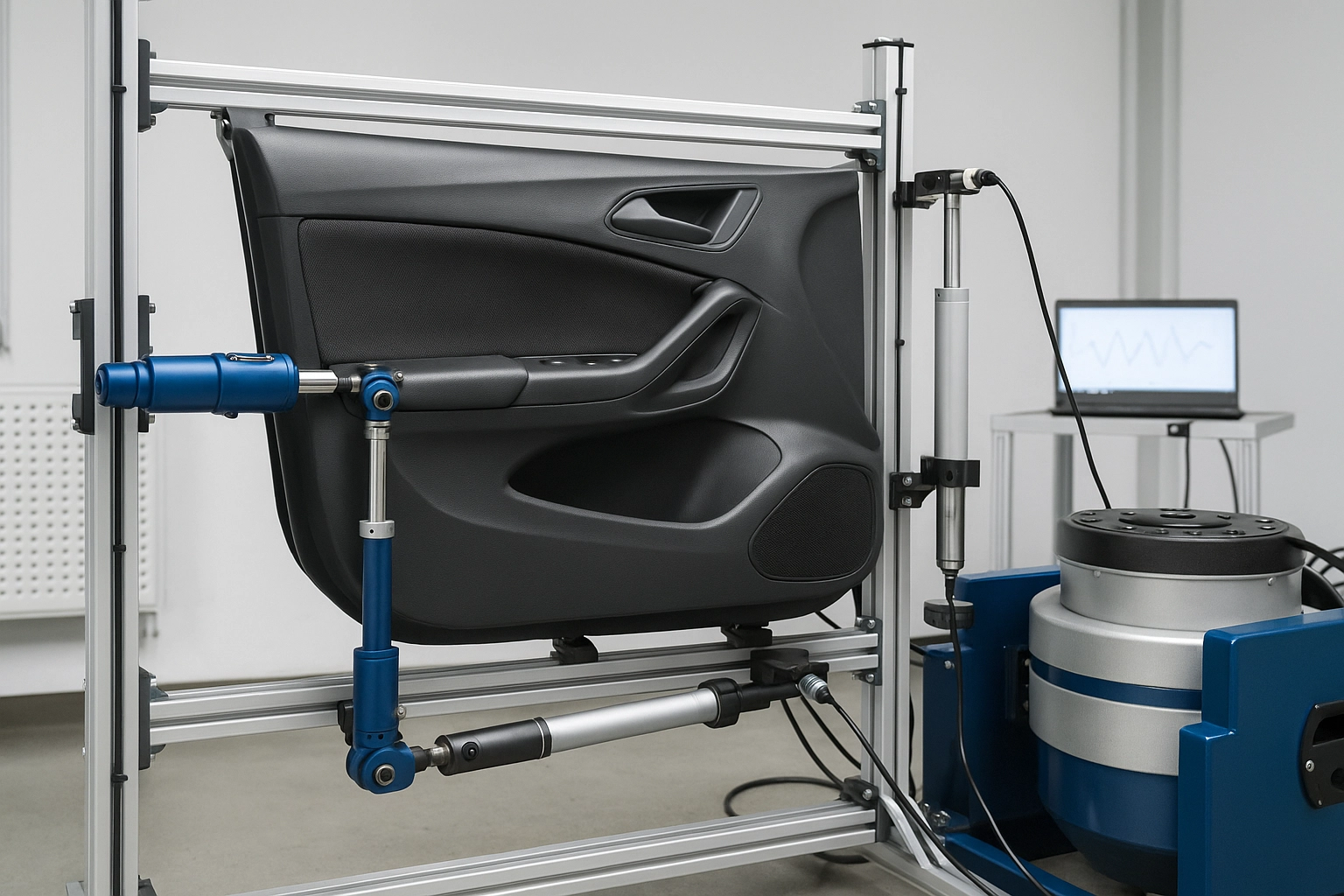DIN 45635 Mechanical Component Vibration BSR Test
The DIN 45635 mechanical component vibration Buzz, Squeak & Rattle (BSR) test is a critical procedure used in the automotive industry to evaluate and ensure the quality of various components that are prone to noise generation. This test focuses on identifying and mitigating sources of unwanted sounds that can arise from vibrations within an automotive system. By adhering to this stringent standard, manufacturers can enhance the overall driving experience by ensuring that their vehicles meet high standards for comfort and reliability.
The DIN 45635 test is particularly important in the development stages of new vehicle models where even minor improvements in noise reduction can significantly impact customer satisfaction. The test involves subjecting mechanical components to controlled vibration environments while monitoring sound levels at different frequencies. This helps engineers pinpoint specific areas within a component that may cause unwanted noise and allows for targeted modifications.
One of the key aspects of this testing method is its ability to simulate real-world driving conditions accurately. By replicating various stress scenarios, including acceleration, deceleration, and road imperfections, the test ensures that any potential issues are exposed early in the design phase. This proactive approach not only saves time but also reduces costs associated with late-stage redesigns.
Another advantage of using DIN 45635 is its focus on both qualitative and quantitative measurements. While traditional methods might rely solely on subjective assessments, this standard provides a more objective evaluation by quantifying sound levels across multiple frequency bands. This data-driven approach allows for precise comparisons between different designs or versions of the same component.
From an engineering perspective, understanding how vibrations contribute to noise generation is essential for improving product design. For instance, identifying resonant frequencies where excessive vibration occurs can lead to significant improvements in structural integrity and material selection. Additionally, this knowledge helps optimize assembly processes and ensure proper lubrication levels which play crucial roles in minimizing noise.
It's worth noting that while the primary goal of DIN 45635 is to minimize noise caused by vibrations within a component, it also indirectly contributes to other quality aspects such as durability and performance. Components that pass this rigorous test are more likely to perform consistently under diverse operating conditions without experiencing premature failure due to excessive stress.
In conclusion, implementing the DIN 45635 mechanical component vibration BSR test early in the development cycle is vital for achieving world-class automotive products. It provides valuable insights into potential noise sources and facilitates informed decisions regarding design changes or material selections that ultimately lead to quieter vehicles with enhanced overall performance.
Why It Matters
The importance of the DIN 45635 mechanical component vibration BSR test cannot be overstated, especially in today’s competitive automotive market. Noise issues are one of the most common complaints from vehicle owners, and addressing these concerns is crucial for maintaining customer satisfaction and loyalty.
- Enhances driving experience: Quieter vehicles contribute to a more pleasant and comfortable ride.
- Promotes brand reputation: Meeting high standards like DIN 45635 reflects positively on the manufacturer’s commitment to quality.
- Reduces warranty claims: By identifying and resolving noise issues early, manufacturers can minimize post-purchase complaints and returns.
- Improves compliance: Ensuring adherence to international standards helps avoid costly penalties associated with non-compliance.
In addition to these benefits, the DIN 45635 test plays a pivotal role in fostering innovation within the industry. It encourages continuous improvement by providing a framework for comparing different approaches and technologies aimed at reducing noise generation. This ongoing effort contributes not only to better products but also to more sustainable practices as manufacturers seek ways to reduce energy consumption and environmental impact.
Ultimately, the success of any automotive product depends heavily on its ability to deliver an exceptional user experience. By investing in thorough testing like DIN 45635, companies can ensure they are delivering precisely that – an outstanding driving experience characterized by minimal noise interference from mechanical components.
Quality and Reliability Assurance
The implementation of the DIN 45635 mechanical component vibration BSR test is integral to maintaining strict quality control measures throughout the entire production process. This stringent standard ensures that each component undergoes rigorous evaluation before being incorporated into final assemblies, thereby reducing the risk of defects reaching customers.
During the testing procedure, components are subjected to controlled vibrational environments designed to mimic real-world driving conditions. These tests measure sound levels across a range of frequencies and analyze how they change over time under various load conditions. The goal is to identify any resonant frequencies where excessive vibration might occur and determine if these vibrations contribute significantly to noise generation.
Once identified, engineers can then make informed decisions about necessary adjustments or optimizations aimed at reducing those specific sources of noise. This could involve modifying certain materials used in the component’s construction, altering design parameters like shape or size, or adjusting assembly techniques during manufacturing processes. In some cases, improvements might also extend to lubrication strategies employed during production.
An important aspect of this testing methodology is its emphasis on repeatability and consistency across all produced units. By ensuring that each iteration passes the same set of criteria, manufacturers can maintain uniform quality standards consistently throughout large-scale productions. This level of precision is particularly critical in high-performance vehicles where even subtle differences in sound levels could have noticeable impacts.
Furthermore, adhering to international standards such as DIN 45635 provides additional assurance that the products meet industry-wide expectations for performance and reliability. Compliance with these guidelines helps establish a benchmark against which other manufacturers can compare their offerings, fostering healthy competition within the market.
In summary, the rigorous application of the DIN 45635 mechanical component vibration BSR test serves as an essential tool in safeguarding quality assurance practices at every stage of development and production. It enables companies to produce reliable products that not only meet but exceed customer expectations while simultaneously enhancing their reputation within the industry.





